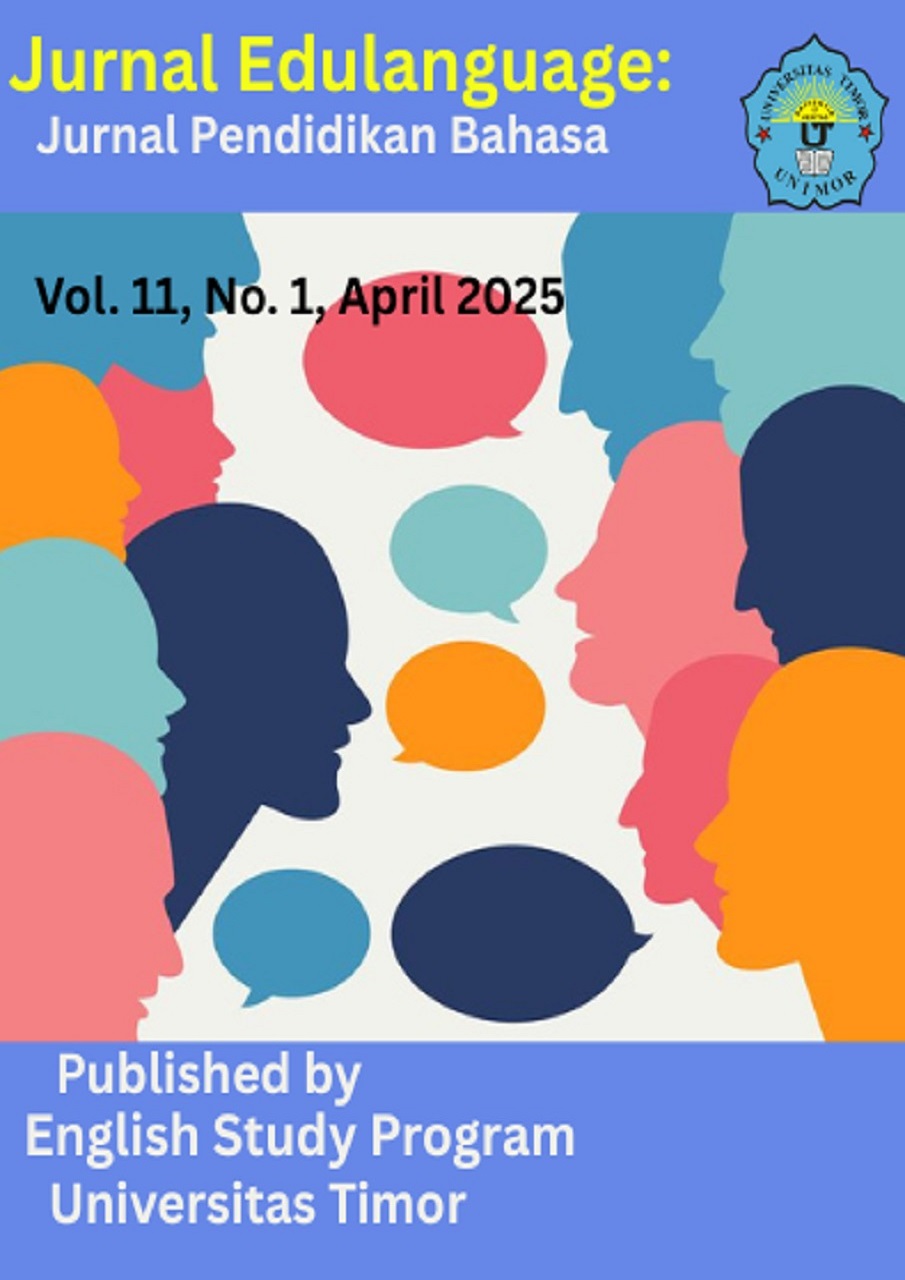The Impact of Sports Demonstration Videos on Students’ Speaking Fluency and Accuracy
DOI:
https://doi.org/10.32938/edulanguage.11.1.2025.16-24Keywords:
accuracy, fluency, sports demonstration videos, second language learning, speaking skills.Abstract
This study analyzes the impact of creating sports demonstration videos on students' speaking fluency and accuracy in English. The research subjects were first-semester students of the Physical Education, Health, and Recreation Program at Universitas Negeri Makassar. Data were collected through video transcript analysis and student questionnaires. The findings indicate that practicing instructional delivery in videos enhances speaking fluency, as shown by reduced pauses and word repetitions. However, in terms of accuracy, errors were still found in grammar, word choice, and pronunciation of technical sports terms. The primary factors affecting accuracy were the lack of speaking practice in academic contexts and insufficient direct correction. This study confirms that project-based tasks, such as video creation, can be an effective strategy for improving students' speaking skills in second language learning.
References
Ambalegin, A., Afriana, A., Purwanti, A., Arianto, T., & Handayani, N. D. (2023). PUBLIC SPEAKING MASTERY FOR SMK GRADUATES’ COMMUNICATION SKILLS: Mastery of public speaking to support the communication skills of vocational school graduates. PUAN INDONESIA, 4(2), 135–142. https://doi.org/10.37296/jpi.v4i2.131
Enny Diah Astuti, Retno Setya Budiasningrum, Jajang Setiawan, Ali Satri Efendi, Rahmi Rosita, & Dyan Yuliana. (2023). Role-Playing Method and the Use of YouTube Platform to Improve Students’ Speaking Skills (Community Service at Madrasah Aliyah Mu’min Cendekia). ALKHIDMAH: Journal of Community Service and Partnership, 1(4), 191–200. https://doi.org/10.59246/alkhidmah.v1i4.547
Heryanto, N. O., & Susilo, S. (2021). Implementation of the Storytelling Learning Model to Improve English Speaking Skills at Mr. Bob English Course. Jurnal Pendidikan Untuk Semua, 5(1).
Hidayat, N., Herlisya, D., & Apriyanto, S. (2022). Public Speaking and Presentation Skill Training in Business Communication Management for Employees. JAMS: Jurnal Abdi Masyarakat Saburai, 3(1). https://doi.org/10.24967/jams.v3i1.1571
Krashen, S. D. (1982). Principles and Practice in Second Language Acquisition. Oxford: Pergamon Press.
Misbahillah, A. K. N., Athallah, A. A., Tasya, A., Sulun, A. R., Fatimah, C., Agustina, D. J., Safirna, G., Setiawan, I., Fadilah, N., Hastuti, P. N., Rahayu, S., & Buntoro, V. G. (2023). Building Confidence in English through Speaking Skill Improvement for Students at SMP Islam Al-Fajar Kedaung - South Tangerang. Jurnal Peradaban Masyarakat, 3(1), 36–41. https://doi.org/10.55182/jpm.v3i1.232
Megawati, M., Fitriani, D., Nurwiatin, N., & Mukaddamah, I. (2022). The Relationship Between Students' Interest in Songs and Their English-Speaking Skills. Jurnal Inovasi Penelitian, 2(11), 3551-3556. https://doi.org/10.47492/jip.v2i11.1392
Meylina, M. (2022). English Public Speaking Training for Millennials in Padang City. Jurnal Pustaka Mitra (Pusat Akses Kajian Mengabdi Terhadap Masyarakat), 2(2), 139–145. https://doi.org/10.55382/jurnalpustakamitra.v2i2.207
Nurhantoro, T. S., Kristiawan, Y. A., Ningsih, I. A., & Wati, W. (2021). English Speaking Skills Training for Students at PPA Domby Kid’s Hope Gajah Wong. National Seminar Proceedings, 3(1).
Rita, D. (2022). Improving English Language Skills Using the Gallery Exhibition Project in English Language Learning on Report Text Topics. Journal of Educational Learning and Innovation (ELIa), 2(1), 96–120. https://doi.org/10.46229/elia.v2i1.397
Shaqila, C., Ilham, I., Rahmaniah, R., Irwandi, I., Bafadal, F., & Hudri, M. (2024). Enhancing English Speaking Skills through Mobile Learning Applications: A Systematic Review. National Seminar Proceedings Paedagoria, 4.
Swain, M. (1985). Communicative competence: Some roles of comprehensible input and comprehensible output in its development. Dalam S. Gass & C. Madden (Eds.), Input in Second Language Acquisition (hlm. 235–253). Rowley, MA: Newbury House.
Downloads
Published
How to Cite
Issue
Section
License
Copyright (c) 2025 Jurnal Edulanguage: Jurnal Pendidikan Bahasa

This work is licensed under a Creative Commons Attribution-NonCommercial-ShareAlike 4.0 International License.
All material contained in this journal is protected by law. It is prohibited to quote part or all of the contents of this journal for commercial purposes without the approval of the editorial board of the Edulanguage journal. If you find one or more articles contained in the Edulanguage Journal that violate or have the potential to violate your copyright, please report it to us via email to the editor of the Edulanguage Journal. Formal legal aspects of access to all information and articles contained in this journal refer to the terms of the Creative Commons Attribution 4.0 license. All information contained in the Edulanguage Journal is academic in nature. Edulanguage Journal is not responsible for losses that occur due to misuse of information from this journal. The author has copyright and full publication of articles published in the Edulanguage Journal.








